TAVI is an exclusive valve replacement surgery for treating people suffering from severe aortic stenosis. The procedure replaces the aortic valve smartly without cutting off or making any incision into the chest. During the surgery, a tiny tube is utilized to penetrate a bioprosthetic valve into the affected valve. The severity of the aortic stenosis becomes the deciding factor of getting the surgery done rather than procrastinating it. The risks of delaying the surgery can lead to heart failure and death due to the short supply of oxygen-rich blood in the body.

A detailed step by step process is involved in the TAVI procedure for treating aortic stenosis.
As an initial step, a tiny cut is made in the upper leg of the patient followed by a minute tube called sheath is penetrated into the femoral artery. The replacement valve is then replaced with the diseased valve with a balloon on the end. The new valve is compressed on the balloon to ease up the opening for closing and opening during the blood supply. By the time the new valve reaches the diseased valve, the balloon is inflated giving room for the positioning of the replaced valve. Finally, your practitioner will double check whether the new valve is working as expected and close the incision in the leg.
Many valves are in the process of implementation to make advancements in the TAVR process. The most commonly used valves are Sapien valve and Corevalve that are most effective in sealing the leaks in the aorta valve via replacement. Sapien valve is a balloon expandable valve made of bovine pericardium and sewn inside a metallic stent. On the other hand, Corevalve expands on its own and is made of porcine pericardine sewn inside a ninitol frame.
The valve is inserted based on the femoral approach. This allows only ambulation and discharge. Few other methods of inserting valves include trans-aortic, trans-axillary, and trans apical. Before TAVR, patients are supposed to go through a detailed CT scan to examine the blood vessel size of the legs to help doctors determine the best suitable method of valve replacement for the patients.
RHL – Rajasthan Hospital
opp. Jaipuria Hospital, Jai Jawan Colony, Milap Nagar, Jaipur, Rajasthan 302018
Lilavati Hospital and Research Centre
A-791, A-791, Bandra Reclamation Rd, General Arunkumar Vaidya Nagar, Bandra West, Mumbai, Maharashtra 400050